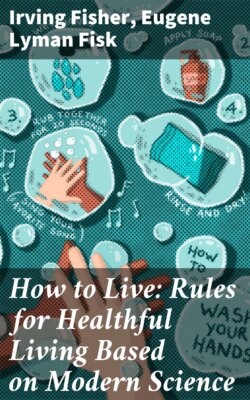Читать книгу How to Live: Rules for Healthful Living Based on Modern Science - Irving Fisher - Страница 35
На сайте Литреса книга снята с продажи.
Section III—Hard, Bulky, and Uncooked Foods
ОглавлениеTable of Contents
The wise choice of foods does not consist entirely in balancing the ration as to protein, fat, and carbohydrate.
Hard Foods
Hard foods, that is, foods that resist the pressure of the teeth, like crusts, toast, hard biscuits or crackers, hard fruits, fibrous vegetables and nuts, are an extremely important feature of a hygienic diet. Hard foods require chewing. This exercises and so preserves the teeth, and insures the flow of saliva and gastric juice. If the food is not only hard, but also dry, it still further invites the flow of saliva. Stale and crusty bread is preferable to soft fresh bread and rolls on which so many people insist. The Igorots of the Philippines have perfect teeth so long as they live on hard, coarse foods. But civilization ruins their teeth when they change to our soft foods.
Bulk Versus Concentrated Foods
Most of the ordinary foods lack bulk; they are too concentrated. For this purpose it is found that we need daily, at the very least, an ounce of cellulose, or “woody fiber.” This is contained in largest measure in fibrous fruits and vegetables—lettuce, celery, spinach, asparagus, cabbage, cauliflower, corn, beets, onions, parsnips, squash, pumpkins, tomatoes, cucumbers, berries, etc.
Until recently would-be food reformers have made the mistake of seeking to secure concentrated dietaries, especially for army rations. It was this tendency that caused Kipling to say, “compressed vegetables and meat biscuits may be nourishing, but what Tommy Atkins needs is bulk in his inside.”
Raw Foods
Vitamins
Cooking is an important art; but some foods when cooked lose certain small components called vitamins, which are also found in the skin or coating of grains, especially rice, also in yolk of egg, raw milk, fresh fruit, and fresh vegetables, especially peas and beans. These vitamins are very important to the well-being of the body. Their absence is probably responsible for certain diseases, such as beriberi, scurvy, and possibly pellagra, as well as much ill health of a less definite sort. Some raw or uncooked foods, therefore, such as lettuce or tomatoes, celery, fruits, nuts, and milk, should be used in order to supply these minute and as yet not well-understood substances which are destroyed by the prolonged cooking at the temperature which is employed in order to sterilize canned foods. They are also diminished and often destroyed by ordinary cooking, except in acid fruits and acid vegetables.
Raw Milk
It is true that only very clean milk is entirely safe in an absolutely raw state, and that heat is usually needed to kill the germs. But this heat, even at the comparatively low temperature of pasteurization, has been found to destroy the vitamins that prevent scurvy. Orange juice should always be given to infants over one month old who are fed pasteurized milk.
Not all foods can be taken raw with advantage. Most starchy foods, such as cereals and potatoes and unripe fruit must, of course, be cooked in order to be made fit to eat.
Disinfection
Raw foods have dangers of their own in carrying germs and parasites, and it is extremely advisable that all raw foods should be very thoroughly washed before eating.
Acids and Inorganic Salts
In addition to protein, fat, carbohydrate, and vitamins, there are other elements which the body requires to maintain chemical equilibrium, and for the proper maintenance of organic functions. These are the fruit and vegetable acids and inorganic salts, especially lime, phosphorus, and iron. These substances are usually supplied, in ample amounts, in a mixed diet, containing a variety of fruits and vegetables and an adequate amount of milk and cream. Potatoes, feared by some in acid condition (such as gout), are actually valuable because of their alkalinity.
